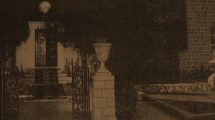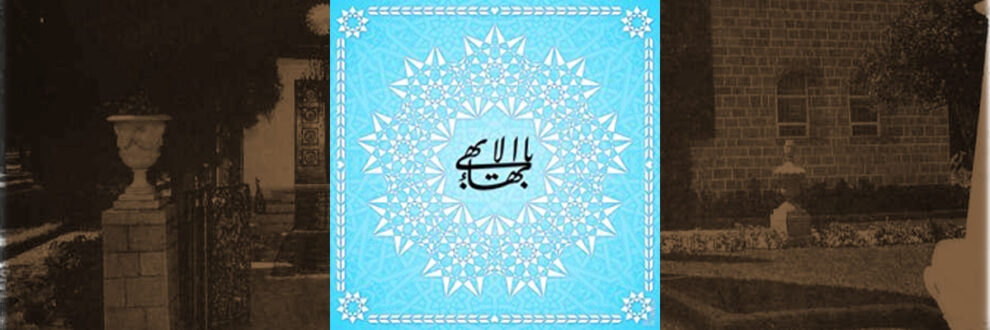 Mulla `Abdu’l-Karim-i-Qazvini
Mulla `Abdu’l-Karim-i-Qazvini
Born: Late 1830s
Death: Unknown
Place of Birth: Qazvin, Iran
Location of Death: Unknown
Burial Location: Unknown
Mulla Abdu’l-Karim-i-Qazvini, a secretary of the Bab. Also called Mirza Ahmad-i-Katib (“the Scribe”) or Mirza Ahmad-i- Qazvini, he was a secretary of the Bab, the teacher of Nabil-i-Zarandi, the historian, and a friend of Bahá’u’lláh. Though of a merchant family, he studied law and theology in his home city of Qazvin with Mulla Abdu’l-Karim-i-Eravani. When his teacher proclaimed him a mujtahid, he doubted his worthiness. After a dream which the Shaykhi merchant Haji Allah-vardiy-i-Farhadi explained as being of Siyyid Kazim-i-Rashti, he went immediately to Karbala with his brother Abdu’l-Hamid and spent the winter in Siyyid Kazim’s classes. After Naw- Ruz Siyyid Kazim sent him back to Qazvin where he worked as a merchant for a number of years. He was apparently married and had children.
Hearing of the Bab’s proclamation, he set out for Shiraz–immediately and on foot, according to one report. Hearing in Tehran that the Bab had instructed his followers to meet him in Karbila, he went there, only to find that the Bab had in fact gone to Bushihr and Shiraz. He joined the party of Shaykhis seeking the Bab, waited for a time in Isfahan, and finally met the Bab with the first group of believers allowed to enter Shiraz. There he became a confirmed believer.
When his followers caused disturbances in the city, the Bab sent most of the believers away but ordered Mulla Abdu’l-Karim to stay and make fair copies of his writings as they were revealed, a task he shared with Shaykh Hasan-i-Zunuzi and Siyyid Husayn-i-Yazdi. Just before the Bab was sent to Isfahan, he sent these three ahead where they continued to act as his secretaries, receiving letters from believers and transcribing the replies. Later when the Bab was living secretly in the house of Manuchihr Khan, they continued this task and were the only believers allowed to see him. After the governor’s death in 1847, he followed the Bab to Kashan, Qum, and Kulayn, where he probably remained for the two to three weeks until the Bab left. He did not see the Bab again.
Mirza Lutf-Ali reports that Mulla Abdu’l-Karim tried to go to the fort of Shaykh Tabarsi with Aqa Muhammad-Jafar-i- Tabrizi but that they were detained in Shir-Gah. Hearing this, Mulla Husayn sent out a party under Mirza Muhammad-Baqir-i-Hirati that brought them to the fort. A few days later Mulla Husayn sent him to Sari to attend Quddus who was detained there. Quddus in turn sent him away with instruction to personally serve the Bab. Another report states that he took part in the disturbances in Khurasan but did not reach the fort (Z H). Both versions are open to doubt since they are not mentioned in Nabil, who otherwise has full particulars on his activities.
Soon after, he settled in Tehran where he lived under the protection of Bahá’u’lláh and worked as a scribe, spending his evenings making copies of the works of the Bab, which he gave as gifts. In late 1848 a young Babi, Nabil-i-Zarandi, arrived in Tehran and settled at the Madrasiy-i- Daru’sh-Shifay-i-Masjid-i-Shah where Mulla Abdu’l-Karim was then living. He befriended Nabil and introduced him to the leading Babis of Tehran, including Bahá’u’lláh and his family.
It was through Mulla Abdu’l-Karim that Bahá’u’lláh corresponded with the Bab after his return from Mazandaran. With him Bahá’u’lláh originated the plan to proclaim Mirza Yahya as the Bab’s successor while keeping him in hiding–this in order to deflect attention from Bahá’u’lláh, who was well known to the authorities and the people.
During the persecutions of February 1850, Mulla Abdu’l-Karim took refuge in the Masjid-i-Shah, the royal mosque adjacent to the madrasih in which he was living. Warned by Bahá’u’lláh that the Amir-Nizam had ordered the Imam-Jumih to arrest him in the sanctuary, he escaped in disguise to Qum. From about this time he was generally known as Mirza Ahmad-i-Katib “the scribe”–a name given him by Bahá’u’lláh, probably as an alias rather than as an honorific. In Qum, shortly before the Bab’s martyrdom, he received a coffer from the Bab containing the last of his writings and his pen-case, seals, rings, and the famous pentacle tablet containing 350 derivatives of the word Baha. He left the same day for Tehran, explaining that the Bab’s accompanying letter ordered him to deliver it to Bahá’u’lláh.
After the Bab’s martyrdom he and Bahá’u’lláh brother, Mirza Musa Kalim, received the remains of the Bab and his disciple. These they hid first in the Imam-Zadih Hasan, then in the house of Haji Sulayman Khan in Tehran, and finally in the Imamzadih Masum, where they remained hidden until 1284/1867-68. In spring of 1851 Nabil found him living incognito in Kirmanshah. During Ramadan in the summer of 1851 Bahá’u’lláh visited them and sent them both back to Tehran. (see Editor’s note below)
A letter survives from about August 1851, soon after Bahá’u’lláh had arrived in Karbala, from Mulla Abdu’l-Karim to Sayyid Javad Karbala’i, in which he complains that a secret shared by himself and the Bab’s other major scribe, Aqa Husayn Katib, was being widely divulged by the Babis. He says that the Babis should cease discussing Bahá’u’lláh’s station, according to the latter’s own wish, and identifies Bahá’u’lláh’s good-pleasure with God’s own: “He said that first of all, tell absolutely everyone that his station should not be divulged more than this. It is only fair that there be a period of silence. God willing, this is incumbent today, In one passage, Qazvini writes of Bahá’u’lláh, in Juan Cole’s translation:
“But it is requested, according to his command, that the friends should desist from hinting around (shivih-ha) about him, as they had in the past, in such a way that they provoked troubles for the friends of God; and that they should avoid bringing sorrow upon that gentleman, who is of gentle disposition. Insofar as he has been in those parts for several days, let them behave in such a manner that he will not experience the dust of perturbation, and conduct themselves in accordance with his good-pleasure, which is, in truth, the good-pleasure of God Himself. Let them not provoke investigations or cause the encounter with God to become more distant, or become a veil of chains and manacles between the servants and the Lord of Lords any more than they already have been. For we have wronged ourselves by virtue of our regrettable actions.”
Mulla Abdu’l-Karim spent the winter of 1851-52 living in a caravansary outside the New Gate of Tehran where he spent his time copying the Bab’s works.
When he and Nabil fell under suspicion once more, he fled to Qum. By summer he was back in Tehran and was arrested at the time of the attempt on the life of the Shah. His brother Abdu’l-Hamid, who had come to urge him to return to Qazvin, was arrested with him. The two brothers were imprisoned in the Siyah-Chal with Bahá’u’lláh until sometime between August 22-26, when both were hacked to pieces with sword by the artillerymen of the royal bodyguard, probably in the present Maydan-i-Arg, adjacent to the artillerymen’s camp and the passage to the Siyah-Chal.
Mirza Ahmad was important as an authority on the writings of the Bab. Several manuscripts in his hand of the Arabic and Persian Bayans survive. He handled the private correspondence of the Bab, Bahá’u’lláh, and Mirza Yahya with discretion. He was also one of Nabil’s principal informants for the inner history of the early Babi period. Modern Bahá’ís know him best as the source through which Mulla Husayn’s famous account of the Bab’s declaration reached Nabil.
The sincerity of his spiritual search is apparent from his own account preserved in Nabil, from the trust placed in him by the Bab and Bahá’u’lláh, and from his own actions: his contentment with the modest stations of merchant and scribe when his learning and piety would have given him an honored place among the ulama, his abrupt departures in search of Siyyid Kazim and the Bab, and his refusal to rejoin his family in Qazvin. He enjoyed the respect and affection of Bahá’u’lláh and his family and the obvious devotion of Nabil.
Editor’s Note:
In H.M. Balyuzi,’s book, Baha’u’llah – The King of Glory (p. 67) he wrote:
Bahá’u’lláh spent most of August 1851, the month of Ramadan (the Muslim month of fasting), in Kirmanshah. There, both Nabil-i-A’zam and Mulla ‘Abdu’l-Karim-i-Qazvini attained His presence. He directed Mulla ‘Abdu’l-Karim to go to Tihran, and Nabil to take Mirza Yahya with him and stay in the vicinity of Shah-rud.
Source:
Walbridge, John. “Mulla ‘Abdu’l-Karim Qazvini (Mirza Ahmad Katib)” Bahai-Library.com: Winters, Jonah
Image:
Art Desgin by Joe Paczkowski





Thanks for all the research and the history of this wonderful and dedicated soul. (I just had a brief question – The date of birth is listed as late 1830’s. I assume this is a misprint, otherwise he would have been transcribing the Writings of the Bab at a very young age.) How awesome that this dear soul apparently recognized the Station of Baha’u’llah before His declaration of His mission. Very very inspiring!